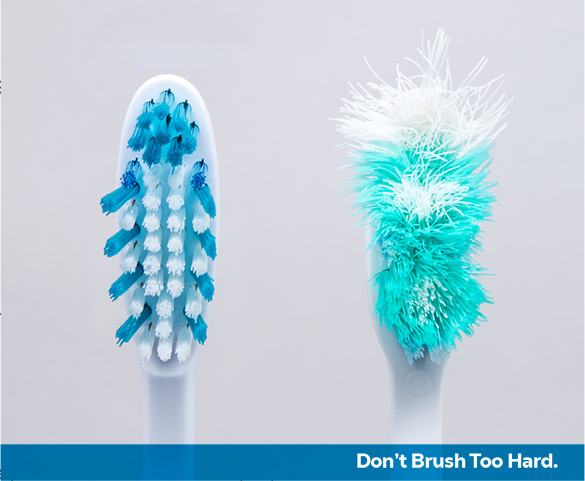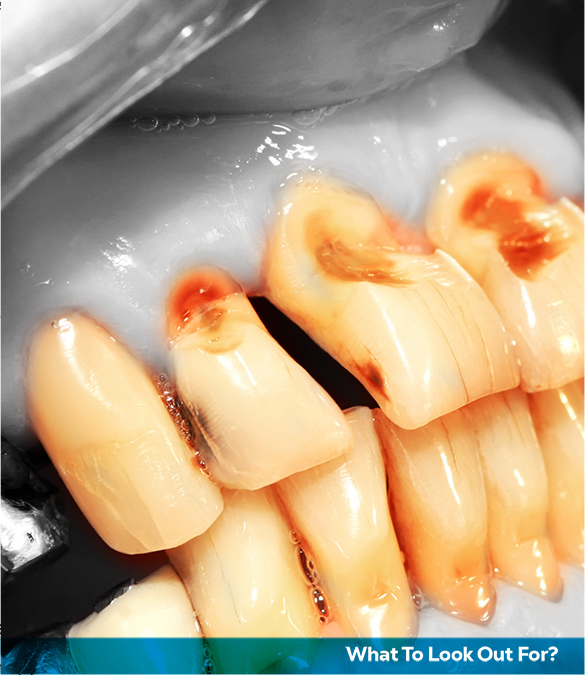
TOOTHBRUSH ABRASION

What Is Toothbrush Abrasion?
Brushing regularly is considered vital for healthy teeth and gums, but dental experts warn that you can overdo a good thing. Toothbrush abrasion is the wear of tooth or gum structures that happens as a result of overzealous brushing. It can happen from using too much force while brushing but it can also happen from using too abrasive of toothpaste or from using too hard of a toothbrush.
What Causes Tooth Abrasion?
The most common cause of tooth abrasion is brushing too hard. Vigorous brushing can wear down the enamel on the teeth as well as damage and push back the gums, exposing the sensitive root area. Receding gums can also lead to other dental problems such as periodontal disease and cavities on the roots of the teeth and may lead to the need for treatments such as fillings, root canals and tooth extraction.

How Do I Know If I Am Brushing Too Hard?
If you are using a soft-bristled toothbrush, you will often know if you are brushing too hard because your toothbrush bristles splay outward within a few weeks or months of getting your toothbrush. If you are using a hard-bristled toothbrush, the bristles may not splay out as easily but you may notice signs of gum tissue recession. You might also notice cold sensitivity or sensitivity to brushing at gum line in areas where toothbrush abrasion is happening.
What Does Toothbrush Abrasion Look Like?
Toothbrush abrasion is pretty easy to spot in its later stages, but you can detect it as soon as it starts.
- Exposed root surface: The first sign is some exposed root surface. This becomes visible because of gum recession, more specifically the wearing away of the cuff of gum by incorrect and over enthusiastic toothbrushing. The first visible evidence of toothbrush abrasion is the junction between the crown (top of your tooth) and the slightly yellower root surface.
- Eaten out (notched) tooth appearance: This root surface is much softer and doesn’t have the strong enamel layer to protect it. Because of this, it wears much more easily and more quickly; over time characteristic scooped out notches begin appearing on your teeth at the gum line. It can look like something has taken a bite out of your teeth.

What Is The Proper Way To Brush?
Often the best way to know if you are brushing incorrectly is to understand what the proper way is to brush. Proper brushing takes being mindful of how you are brushing. Here are some helpful tips and guidelines to follow when it comes to brushing your teeth:
- Brush your teeth for two to three minutes to get the most thorough cleaning.
- Use a soft-bristled toothbrush or electric tooth brush to prevent gum damage of the soft tooth dentin (the less mineralised layer of tooth found just under the enamel) and in the root area.
- Place the head of your toothbrush with the tips of the bristles at a 45-degree-angle to the gum line when brushing.
- Use short, circular motions when brushing your teeth instead of going up and down or side to side.
- Apply just enough pressure to feel the bristles against the gums. If you are squashing the bristles, you’re brushing too hard.
What Can Be Done For Toothbrush Abrasion?
First of all, try to figure out what has contributed to your toothbrush abrasion. Is it too hard of bristles, too much brushing pressure, or just plain over-brushing? Once you have figured that out, change your ways of brushing to prevent any further damage.
Other treatment can range from sensitive toothpastes, in-office application of desensitising agents, or to filling deep lesions. However, none of these treatments will be longstanding or effective if the abrasive cause is continued.
If you think you may be experiencing sensitivity, gum recession, or other abrasion symptoms, it is a good idea to discuss this with your dentist. Addressing these issues in a timely manner can save you from problems in the long term.
1 June 2022, Tooth Stories Team
